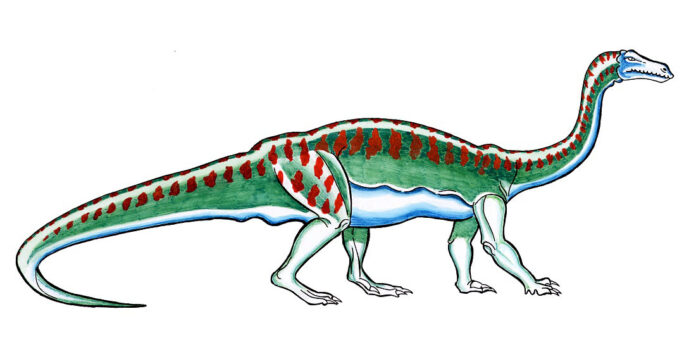Scientists have excavated the largest dinosaur fossil which would have been the largest terrestrial animal on our planet.
A team of scientists from South Africa, UK and Brazil led by University of Witwatersrand have discovered a fossil of a new species of dinosaur in South Africa thought to be a related to brontosaurus. This early Jurassic dinosaur weighed a huge 26,000 pounds i.e. double the size of an African elephant, and stands four meters at hip. It has been named ‘Ledumahadi mafube’ meaning ‘giant thunderclap at dawn’ in the indigenous language Sesotho of the region where it was discovered.
An evolutionary transition
Ledumahadi is closely related to sauropod dinosaurs including the well-known species Brontosaurus and Diplodocus. It was a plant-eating herbivore, had thick limbs and was a quadruped i.e. it walked on all four legs in a posture similar to modern elephants. Compared to sauropod’s long, slender columnar limbs, Ledumahadi’s forelimbs were more crouched i.e. it had more flexed limbs like primitive dinosaurs. Their ancestors walked on two legs only and they must have adapted to walk on all four and that is why they grew larger to support digestion as they were herbivores.
Researchers compared fossil data from dinosaurs, reptiles etc who walked on two or four legs and they measured limb size and thickness. This is how they concluded Ledumahadi’s posture and its way of walking on all four limbs. It is understood that many other dinosaurs must have experimented walking on all four limbs which could optimally balance a bigger body. Based upon these collective observations, researchers say that Ledumahadi was definitely a ‘transitional’ dinosaur, as it had ‘crouched’ yet very thick limbs to support its large body. Their limb bones– both arms and legs – are very robust and similar in shape to giant sauropod dinosaurs but obviously thicker while sauropods had more slender limbs. The evolution of four-legged postures came before their giant bodies. Just sheer size and elephant-like limb posture helped them, example sauropods, to become one of the most dominant dinosaur groups during the Jurassic era. Ledumahadi definitely represents a transitional stage between two major groups of dinosaurs. The group of early dinosaurs were experimenting with various ways of becoming bigger in size during the first tens of millions of years of their evolution. What it means for research is that the evolutionary transition from a small, bipedal creature to a large, quadrupled sauropod is a complex path and this evolution certainly led to survival and achieving dominance.
The discovery published tells us that even more than 200 million years ago, these dinosaurs were the largest vertebrates to be present on the planet, and this time period was almost 40-50 million years earlier than giant sauropods were first seen. The new dinosaur is closely related to giant dinosaurs who lived in Argentina around that time supporting the idea that all continents that we see today were assembled as Pangea – a supercontinent comprised of world’s land mass during Early Jurassic. And at that time this region of South Africa was not mountainous as we see it today but was flat and semi-arid with shallow streams. Certainly, it was a thriving ecosystem. Like Ledumahadi, many other dinosaurs – both giant and tiny – roamed the place at the time. It is fascinating that South Africa has helped to understand the rise of giant dinosaurs during Jurassic era.
***
{You may read the original research paper by clicking the DOI link given below in the list of cited source(s)}
Source(s)
McPhee BW et al 2018. Giant Dinosaur from the Earliest Jurassic of South Africa and the Transition to Quadrupedality in Early Sauropodomorphs. Science. 28(19). https://doi.org/10.1016/j.cub.2018.07.063
***




































